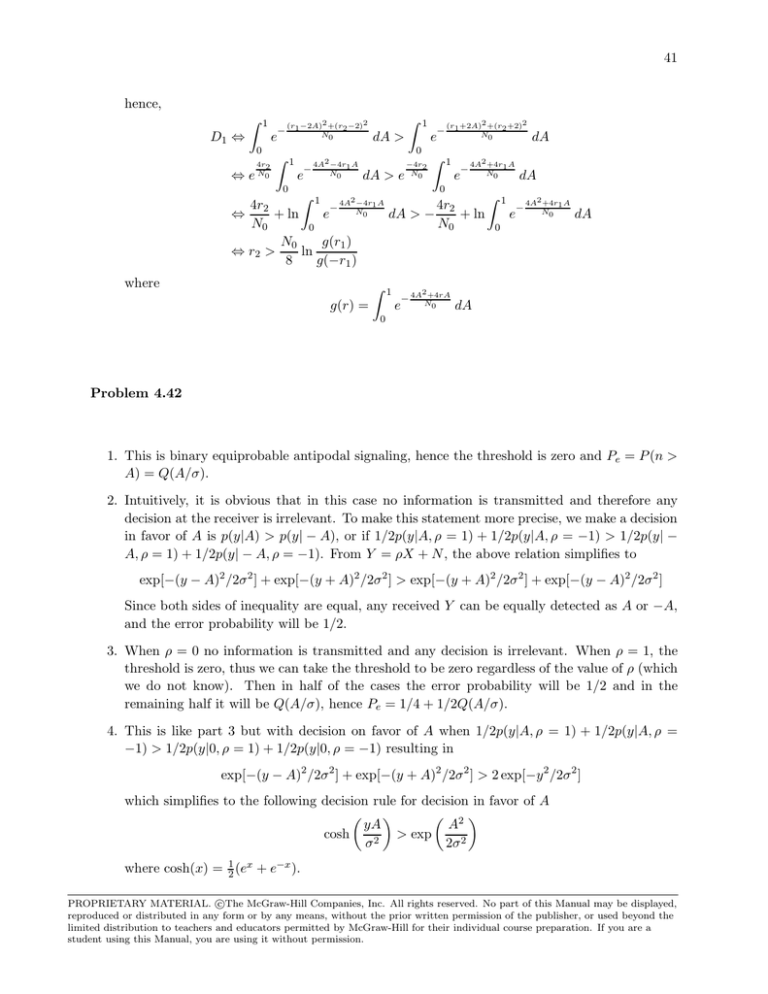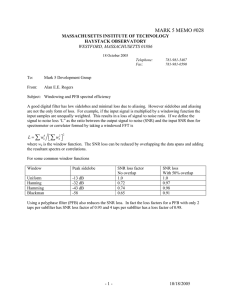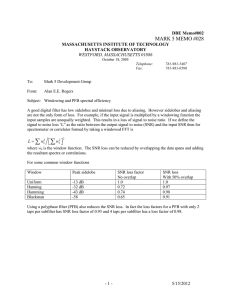
41
hence,
D1 ⇔
Z
1
0
4r2
⇔ e N0
−
e
Z
(r1 −2A)2 +(r2 −2)2
N0
1
−
dA >
4A2 −4r1 A
Z
1
0
−4r2
−
e
Z
(r1 +2A)2 +(r2 +2)2
N0
1
−
dA
4A2 +4r1 A
N0
N0
e
e
dA > e N0
dA
0
0
Z 1 4A2 −4r A
Z 1 4A2 +4r A
1
1
4r2
4r2
−
−
N
N0
0
⇔
dA > −
dA
e
e
+ ln
+ ln
N0
N0
0
0
N0
g(r1 )
⇔ r2 >
ln
8
g(−r1 )
where
g(r) =
Z
1
2
− 4A N+4rA
e
0
dA
0
Problem 4.42
1. This is binary equiprobable antipodal signaling, hence the threshold is zero and Pe = P (n >
A) = Q(A/σ).
2. Intuitively, it is obvious that in this case no information is transmitted and therefore any
decision at the receiver is irrelevant. To make this statement more precise, we make a decision
in favor of A is p(y|A) > p(y| − A), or if 1/2p(y|A, ρ = 1) + 1/2p(y|A, ρ = −1) > 1/2p(y| −
A, ρ = 1) + 1/2p(y| − A, ρ = −1). From Y = ρX + N , the above relation simplifies to
exp[−(y − A)2 /2σ 2 ] + exp[−(y + A)2 /2σ 2 ] > exp[−(y + A)2 /2σ 2 ] + exp[−(y − A)2 /2σ 2 ]
Since both sides of inequality are equal, any received Y can be equally detected as A or −A,
and the error probability will be 1/2.
3. When ρ = 0 no information is transmitted and any decision is irrelevant. When ρ = 1, the
threshold is zero, thus we can take the threshold to be zero regardless of the value of ρ (which
we do not know). Then in half of the cases the error probability will be 1/2 and in the
remaining half it will be Q(A/σ), hence Pe = 1/4 + 1/2Q(A/σ).
4. This is like part 3 but with decision on favor of A when 1/2p(y|A, ρ = 1) + 1/2p(y|A, ρ =
−1) > 1/2p(y|0, ρ = 1) + 1/2p(y|0, ρ = −1) resulting in
exp[−(y − A)2 /2σ 2 ] + exp[−(y + A)2 /2σ 2 ] > 2 exp[−y 2 /2σ 2 ]
which simplifies to the following decision rule for decision in favor of A
2
yA
A
cosh
> exp
σ2
2σ 2
where cosh(x) = 21 (ex + e−x ).
c
PROPRIETARY MATERIAL. The
McGraw-Hill Companies, Inc. All rights reserved. No part of this Manual may be displayed,
reproduced or distributed in any form or by any means, without the prior written permission of the publisher, or used beyond the
limited distribution to teachers and educators permitted by McGraw-Hill for their individual course preparation. If you are a
student using this Manual, you are using it without permission.
43
where x1 and x2 are vector representations for x(t) and x(t−1). This means that the decision
regions will not change. For the error probability we have
if s2 (t) is x(t), then
qtwo cases,
d = 0 and pe = Q(0) = 21 . If s2 (t) = x(t − 1), then pe = Q
1 1 1
pe = × + × Q
2 2 2
r
2
3N0
1 1
= + Q
4 2
2
3N0
r
. Therefore,
2
3N0
This indicates a major deterioration in performance.
Problem 4.44
1. Using the definition of Q-function Q(x) =
Z
∞
R∞
x
2
t
√1 e− 2
2π
dt we have
x2
x
Q(βx) 2 e− 2σ2 dx
σ
Z0 ∞ Z ∞
2
x2
1
x
− t2
√
=
e
dt 2 e− 2σ2 dx
σ
2π βx
0
E [Q(βX)] =
where the region of integration is 0 ≤ x < ∞ and βx ≤ t < ∞. Reordering integrals we have
#
"Z t
Z ∞
x2
β x
1 − t2
−
√ e 2
E [Q(βX)] =
e 2σ2 dx dt
2
2π
0
0 σ
Z ∞
2
2
1
− t2 2
− t2
=√
dt
e
1 − e 2β σ
2π 0
”
Z ∞ t2 “
1
1
− 2 1+ 21 2
β
σ
e
= −√
dt
2
2π 0
s
Z ∞
2
1
1
β 2 σ2
− s2
√
= −
e
ds
2
1 + β 2 σ 2 2π 0
s
!
β 2σ2
1
1−
=
2
1 + β 2 σ2
where we have used the change of variables s = t
2. This is similar to case 1 with β =
q
2Eb
N0 ,
q
1+β 2 σ2
β 2 σ2 .
therefore
v
u
b
u σ 2 2E
1
N0
1−t
E[Pb ] =
b
2
1 + σ 2 2E
N
0
c
PROPRIETARY MATERIAL. The
McGraw-Hill Companies, Inc. All rights reserved. No part of this Manual may be displayed,
reproduced or distributed in any form or by any means, without the prior written permission of the publisher, or used beyond the
limited distribution to teachers and educators permitted by McGraw-Hill for their individual course preparation. If you are a
student using this Manual, you are using it without permission.
44
3. Obviously here
v
u
2 Eb
u
σ
1
N0
E[Pb ] = 1 − t
Eb
2
1 + σ2 N
0
Eb
4. Note that for σ 2 N
≫ 1, we have
0
v
s
u
b
u σ 2 2E
1
N
0
t
= 1−
2Eb
b
2
1 + σ N0
1 + σ 2 2E
N0
≈1−
1
Eb
2 + 4σ 2 N
0
√
where we have used the approximation that for small ǫ, 1 − ǫ ≈ 1 − 2ǫ . From the above we
have
q
SNR
1
1 1 −
≈ 4 SNR
antipodal
2
1+SNR q
E[Pb ] =
1
SNR
1 1 −
≈ 2 SNR
orthogonal
2
2+SNR
5. We have
h
−βX 2
E e
i
=
Z
∞
e−βx
Z0 ∞
2
x − x22
e 2σ dx
σ2
x − x22 (1+2βσ2 )
dx
e 2σ
σ2
0
Z ∞
t2
1
=
te− 2 dt
2
1 + 2βσ 0
1
=
1 + 2βσ 2
1
for βσ 2 ≫ 1
≈
2βσ 2
q
2
. We will see later that the error
where we have used the change of variables t = x 1+2βσ
σ2
=
E
probability for noncoherent detection of BFSK is Pb =
E
− b
Pb = 21 e N0 . If we
Eb
and obtain
β=N
0
b
1 − 2N0
e
2
and for binary DPSK is
have Rayleigh attenuation as in part 2, we can substitute β =
E[Pb ] =
(
1
1
≈ SNR
2+SNR
1
1
≈ 2 SNR
2+2 SNR
Eb
2N0
and
noncoherent BFSK
binary DPSK
As noticed from parts 4 and 5, all error probabilities are inversely proportional to SNR.
c
PROPRIETARY MATERIAL. The
McGraw-Hill Companies, Inc. All rights reserved. No part of this Manual may be displayed,
reproduced or distributed in any form or by any means, without the prior written permission of the publisher, or used beyond the
limited distribution to teachers and educators permitted by McGraw-Hill for their individual course preparation. If you are a
student using this Manual, you are using it without permission.
51
Problem 4.49
√
r(t) = (r1 (t), r2 (t)) = (s(t) + n1 (t), As(t) + n2√
(t)), where s(t) = ± Eφ(t). Projecting on φ(t)
gives r = (r1 , r2 ) = (s + n1 , As + n2 ), with s = ± E.
√
1. ŝ = arg max p(r|s) = pn1 (r1 − s) 12 pn2 (r2 − s) + 21 pn2 (r2 + s) . Since s = ± E, the term in
the parenthesis can be ignored q
and ŝ = arg max p(r|s) = pn1 (r1 − s), resulting in the decision
rule D1 ⇔ r1 > 0, and pe = Q
2. Here C =
1
1
2
1
2
1
and C −1 =
2E
N0
4
3
− 32
.
− 23
.
4
3
This results in
2
2
2
p(n1 , n2 ) ∝ e− 3 (n1 +n2 −n1 n2 )
and the decision rule becomes ŝ = arg max 21 p(r1 − s, r2 − s) + 12 p(r1 − s, r2 + s). This relation
cannot be much simplified. Some reduction is possible resulting in
√
sinh 32 E(r1 + r2 )
4
√
> e− 3 E
D1 ⇔
sinh 2 E(r2 − r1 )
2
. The decision rule is
3. Here r(t) = (1 + A)s(t) + n(t) where the PSD of n(t) is N1 +N
2
1
1
arg max 2 pn (r − 2s) + 2 pn (r), resulting in arg max pn (r − 2s), which reduces to D1 ⇔ r > 0.
Note that although the decision rule in this case is very similar to case 1, but the error
probability in this case is much higher.
4. The setting is similar to case 1. The decision rule is arg max 21 pn1 (r1 −s) (pn2 (r2 − s) + pn2 (r2 )).
Some reduction is possible,
√
2r2 E−E
√
√
cosh
4r2 E
4r1 E
2N2
− N
+ NE
− N
1
2
2
>e
√
D1 ⇔
cosh 2r22NE+E
2
5. In this case r = ((1−A)s+n1 , As+n2 ), and the decision rule becomes arg max 21 pn1 (r1 )pn2 (r2 −
s) + 21 pn1 (r1 − s)pn2 (r2 ). This reduces to
√ !
√ !
2r1 E
2r2 E
D1 ⇔ sinh
+ sinh
> 0 ⇔ r1 + r2 > 0
N1
N2
Problem 4.50
c
PROPRIETARY MATERIAL. The
McGraw-Hill Companies, Inc. All rights reserved. No part of this Manual may be displayed,
reproduced or distributed in any form or by any means, without the prior written permission of the publisher, or used beyond the
limited distribution to teachers and educators permitted by McGraw-Hill for their individual course preparation. If you are a
student using this Manual, you are using it without permission.
52
1. Since a takes only nonnegative values the threshold of the binary antipodal signaling scheme
always remains at zero and the decision rule is similar to an AWGN channel.
p
2. For a given value of a we have Pb = Q a Eb /N0 . We have to average the above value
over all a’s to obtain the error probability. This is done similar to the integration in part 1
of Problem 4.44 to give
s
!
Eb /N0
1
Pb =
1−
2
1 + Eb /N0
where we have used the fact that σ 2 parameter in the Rayleigh distribution given above is
1/2.
3. For large SNR values
1
Eb /N0
=
≈ 1 − 1/(Eb /N0 ) ≈ (1 − 1/(2Eb /N0 ))2
1 + Eb /N0
1 + 1/(Eb /N0 )
Hence,
Pb ≈
1
1
(1 − 1 + 1/(2Eb /N0 )) =
2
4Eb /N0
4. For an AWGN channel an error probability of 10−5 is achieved at Eb /N0 of 9.6 dB. For a
fading channel from 10−5 = 4Eb1/N0 we have Eb /N0 = 105 /4 = 25000 or 44 dB, a difference of
34.4 dB.
2
5. For orthogonal signaling and noncoherent detection Pb = 21 e−a Eb /2N0 . We need to average
this using the PDF of a to determine the error probability. This is done similar to part 5 of
Problem 4.44. The result is Pb = 1/(2 + Eb /N0 ).
Problem 4.51
R
Define φ1 (t) = g1 (t) and α = g2 (t)g1 (t) dt, then by Gram-Schmidt
√ g2 (t) = αφ1 (t) + βφ2 (t)
where φ2 (t) is the normalized version of g2 (t) − αg1 (t), and β = 1 − α2 . Now from r(t) =
s1 (t) + s2 (t) + n(t) we have the following mappings
(m1 , m2 ) = (1, 1) ⇔ s11 = (1 + α, β)
(m1 , m2 ) = (1, 2) ⇔ s12 = (1 − α, −β)
(m1 , m2 ) = (2, 1) ⇔ s21 = (−1 + α, β)
(m1 , m2 ) = (2, 2) ⇔ s22 = (−1 − α, −β)
(4.0.1)
(4.0.2)
(4.0.3)
(4.0.4)
and r = s + n.
c
PROPRIETARY MATERIAL. The
McGraw-Hill Companies, Inc. All rights reserved. No part of this Manual may be displayed,
reproduced or distributed in any form or by any means, without the prior written permission of the publisher, or used beyond the
limited distribution to teachers and educators permitted by McGraw-Hill for their individual course preparation. If you are a
student using this Manual, you are using it without permission.





